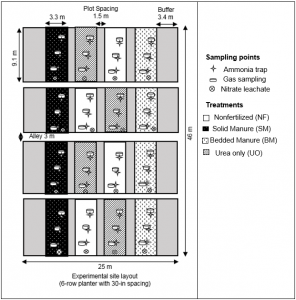When manure is used as fertilizer on crop land, it has been shown to improve soil health and increase crop yields compared to commercial fertilizer. However, the nutrients in manure can be quite variable. Little is known about the potential emissions of ammonia and greenhouse gases (carbon dioxide, methane, and nitrous oxide) when manure is used as a nitrogen fertilizer. These emissions can lead to nutrient losses and environmental degradation. There is limited information on the influence of land application of solid beef manure on overall gaseous emissions. The ongoing integration of beef cattle manure and crop production, together with the impacts of management decisions needs to be understood to be sustainable at multiple levels. Furthermore, gaseous emissions and the mitigation from land-applied manure needs to be comparatively assessed with commercial fertilizer to fully understand management modifications on crop production. The purposes of this study were (i) to estimate daily and seasonal emission/uptake rates of CO2, CH4, N2O, and NH3 and soil inorganic N levels under different N sources in corn cropping system; (ii) to identify important soil and weather control variables for gaseous emissions; and (iii) to assess the effects of different N management strategies (manure vs. urea) on corn yield and grain quality.
What did we do?
A 2-yr field experiment was conducted during the 2016 and 2017 growing seasons at the North Dakota State University (NDSU) research farm in Fargo, ND. The soil was poorly drained Fargo-Ryan silty clay. The experimental design was randomized with four replications. The treatments used were: (i) no fertilizer (NF) control (ii) solid beef cattle manure (SM) applied at 34 and 20.2 Mg ha−1 in the preceding fall of Year 1 (15 Oct. 2015) and Year 2 (19 Oct. 2016), respectively; (iii) solid beef cattle manure with wheat straw bedding (BM) applied at 67.3 and 43 Mg ha−1 in the preceding fall of Year 1 and Year 2, respectively; and (iv) urea only (UO) (46–0-0) applied at 220 kg ha−1 in May of Year 1 (4 May 2016) and Year 2 (9 May 2017). In addition, 117 kg P ha−1 (Year 1) and 88 kg P ha−1 (Year 2) were applied to UO plots to meet the corn P demand. Phosphorus was supplied with triple superphosphate (0–45–0). For measuring N2O, CO2, and CH4 fluxes from the soil surface, headspace gas samples were collected using PVC static chambers. Ammonia volatilization losses from each plot were measured using a semi-static open chamber (trap). Emissions of GHGs and NH3 were calculated for (i) daily mean soil to atmosphere fluxes for Year 1 and Year 2 and (ii) cumulative growing season emission for Year 1 (May 2016–September 2016) and Year 2 (May 2017–September 2017).
Figure: Experimental plots set up for measuring greenhouse gas fluxes using PVC static chambers from the soil surface in Fargo, North Dakota. (Photo credit: Suresh Niraula)
What have we learned?
Manure applied to soil reduced cumulative nitrous oxide by 23% in SM and 31% in BM compared with the UO soil. Cumulative CO2 emission was 42% lower in UO than in SM or BM. Cumulative methane emission ranged from −0.04 (NF) to 0.21 (BM) kg CH4–C ha−1, with the highest emission from BM. Cumulative NH3 emission was 11% lower from manure treatments than UO. The results highlight the challenges that come with variability in manure, soil, and weather as well as the potential for meeting crop N demand while reducing greenhouse gas emissions when using manure as an N source. With contrasting weather patterns during the Year 1 and Year 2 growing seasons, this study emphasized the importance of long-term study to fully understand the emission trend because an individual year may not fully account for variabilities in soil N indices. In addition, further research on biogeochemical processes in soil of fall-applied manure compared with spring-applied urea is needed to overcome the limitation of this study.
Future plans
We recommend the use of an automated chamber from gaseous emissions to continuously build on existing guidelines for the use of static chambers. More research is needed in several other types of agricultural management systems to investigate the loss of soil and manure N.
Authors
Dr. Suresh Niraula, Postdoctoral Associate, Department of Soil, Water, and Climate – University of Minnesota (Corresponding author email: sniraula@umn.edu)
Dr. Shafiqur Rahman, Associate Professor Agricultural and Biosystems Engineering (North Dakota State University)
Dr. Amitava Chatterjee, Associate Professor Soil Science (North Dakota State University)
Acknowledgements
This material is based on work that is supported by the National Institute of Food and Agriculture, USDA (grant 2015-67020-23453). Any opinions, findings, conclusions, or recommendations expressed in this publication are those of the author(s) and do not necessarily reflect the view of the USDA.
Additional information
Jantalia, C., A. Halvorson, R. Follett, B. Alves, J. Polidoro, and S. Urquiaga. 2012. Nitrogen source effects on ammonia volatilization as measured with semi-static chambers. Agron. J. 104(6): 1595–1603. doi:10.2134/agronj2012.0210.
Parkin, T.B., and R.T. Venterea. 2010. Chapter 3. Chamber-Based Trace Gas Flux Measurements. In Follett, R.F. (ed.), Sampling Protocols. p. 3–39.
The authors are solely responsible for the content of these proceedings. The technical information does not necessarily reflect the official position of the sponsoring agencies or institutions represented by planning committee members, and inclusion and distribution herein does not constitute an endorsement of views expressed by the same. Printed materials included herein are not refereed publications. Citations should appear as follows. EXAMPLE: Authors. 2019. Title of presentation. Waste to Worth. Minneapolis, MN. April 22-26, 2019. URL of this page. Accessed on: today’s date.



